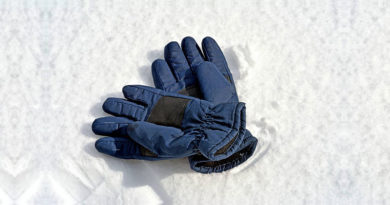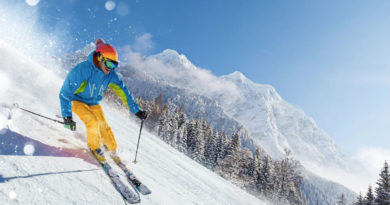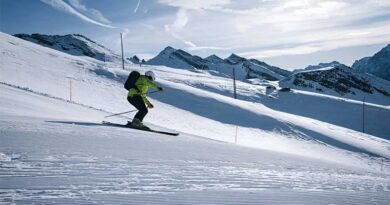Best Ski Boots for High Arches of 2025
Finding the perfect ski boot can be tricky, especially if you have high arches. Arch support doesn’t come from the boot itself. You can purchase whatever your favorite boots and add aftermarket insoles for extra comfort and support. Two of my favorite insteps are the EZFit QF Insoles and the PCSsole Orthotic Insoles. In this article, I’ll share some of the best ski boots and discuss how to choose the right boot for your feet. I’ll also provide tips on how to add aftermarket insoles for a custom fit.
1. Tecnica Mach1 MV 120
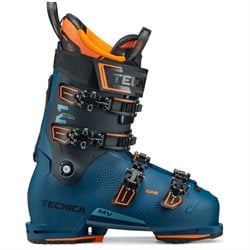
Last: 98, 100, or 103mm
Flex: 120 (stiff)
Binding Compatibility: GripWalk
Ability Level: Advanced-Expert
The Tecnica Mach1 MV 120 Ski Boots are a top choice for expert-level skiers. With a mid-volume 100mm last, they fit most average with high arches comfortably right out of the box. The C.A.S. shell is designed with an anatomical shape that mirrors the foot for a snug fit. Its dimples make the customization process easier, allowing bootfitters to adjust the boot precisely. This level of customization, including the thermo-moldable liner and tongue, ensures these boots can be tailored perfectly for each skier. The 120 flex is stiff, offering fast rebound and response, making it ideal for expert skiers who want a dynamic ride.
What sets the Mach1 MV 120 apart is its T-Drive technology. This feature ensures the boot’s flex remains consistent regardless of the temperature, providing great stability and precision. The Ecodesign C.A.S. Performance liner is not only comfortable but durable, with excellent heel hold that lasts season after season. The boots also feature Celliant® insulation, which converts body heat into infrared energy to enhance circulation and warmth. Combined with four micro-adjustable buckles, easy step-in design, and great edge grip, these boots offer both comfort and performance. They are versatile enough for all-mountain skiing while maintaining expert-level control, making them a favorite for advanced skiers.
What I like: Top-end fit customization and all-around performance.
What I don’t: Expensive
See the Tecnica Mach1 MV See the Women’s Mach1 MV
2. Nordica Cruise 120
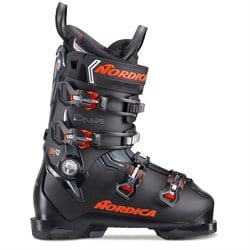
Last: 104mm
Flex: 120 (stiff)
Binding Compatibility: GripWalk
Ability Level: Advanced-Expert
The Nordica Cruise 120 is a fantastic option for skiers with wide, high-volume feet who want both comfort and performance. With a 104mm last, it offers plenty of room right out of the box, making it one of the most comfortable ski boots available for wide feet. The 120 flex is perfect for advanced to expert-level skiers, providing solid control without being too stiff. The Instep Volume Control feature lets you quickly adjust the instep height, so you can fine-tune the fit as needed. The Dual Easy Entry Instep makes getting in and out of the boot a breeze, thanks to its soft plastic flaps.
The Cruise 120 doesn’t compromise on performance despite its focus on comfort. Its polyurethane shell and cuff offer durability and solid support. The Precision Fit TF Liner provides a snug fit, ensuring you stay warm on the slopes. The Adjustable Cuff Profile gives you more control over the boot’s volume, while the four micro-adjustable aluminum buckles allow for a more customized fit. The GripWalk soles add extra traction and stability, making walking around in these boots easier and safer. If you’ve struggled with finding a comfortable boot for wider feet, the Cruise 120 could be the game-changer you’re looking for.
What I like: Affordable, great arch support, and adjustable features for customization.
What I don’t: Can be soft for the heaviest and most aggressive skiers.
See the Nordica Cruise See the Women’s Cruise 75
3. Rossignol Evo 70
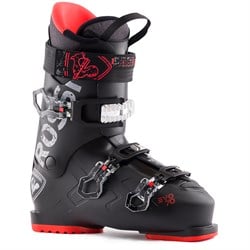
Last: 104mm
Flex: 70
Binding Compatibility: Alpine
Ability Level: Beginner-Intermediate
The Rossignol Evo 70 Ski Boots are an excellent choice for beginners or intermediate skiers. Their comfort is a standout feature, thanks to the 104 mm last, which provides a roomy fit for wider feet. This includes extra space in the forefoot, toe box, and ankle area, while still offering good heel support. The easy-entry system makes getting the boots on and off a breeze. A softer plastic insert at the instep helps the boot open more easily, reducing the struggle some might experience with tighter boots. The 70 flex rating offers a forgiving and soft feel, perfect for those looking to improve their skills on the slopes without dealing with stiff, unmanageable boots.
The Custom T4 liner also adds to the comfort, with a snug, sock-like fit that wraps the foot nicely. The shell design, using Rossignol’s Sensor Matrix, keeps the boot lightweight while maintaining the rigidity needed for good power and precision. However, one drawback is the design of the buckles, particularly the one at the toe. They are difficult to open due to limited space for your fingers. You may need a tool to release them, which seems like a strange design flaw. That said, the three micro-adjust aluminum buckles and the 35 mm power strap provide solid support. The boots also come with replaceable soles, and GripWalk soles can be bought separately for added convenience. Overall, the Evo 70 offers a great balance of comfort and performance for those new to skiing.
What I like: Easy to slip on and fasten, comfortable to wear, and stylish in appearance.
What I don’t: Buckles are hard to release
4. Nordica Speedmachine 3 100
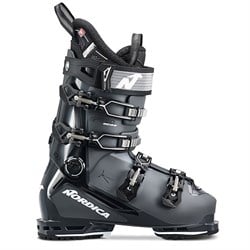
Last: 100mm
Flex: 100
Binding Compatibility: GripWalk
Ability Level: Intermediate-Advanced
The Nordica Speedmachine 3 100 Ski Boots are a great choice for intermediate skiers. With a medium 100 flex, they offer a nice balance between control and comfort. The 100mm last makes them a perfect fit for most average-width feet, giving you a snug yet comfortable experience on the slopes. One of the standout features is how easy these boots are to put on and take off, thanks to the soft plastic flaps in the instep. The Tri-Force construction blends hard and soft materials, ensuring both flexibility and support. The 35mm Velcro power strap and four micro-adjustable buckles allow for a precise fit, further improving the overall performance.
Nordica has really nailed customization with these boots. The Tri-Fit and Infrared Fit technologies allow for a fully personalized fit, especially in problem areas. The heat-moldable liner and shell mean you can adjust them without damaging the boot. Additionally, the Comfort Fit Force Liner is waterproof, warm, and soft, making long days on the mountain more enjoyable. The GripWalk soles provide excellent traction and stability when walking on icy surfaces, a feature many skiers will appreciate. While not as high-performing as some more expensive models, the Speedmachine 3 100 still delivers excellent value and comfort, especially for those who ski a few times a year.
What I like: Excellent fit customization, comfort, and value.
What I don’t: Not a high-performance piece.
See the Nordica Speedmachine 3 100 See the Women’s Speedmachine 3 85
5. Salomon S/Pro Supra 100
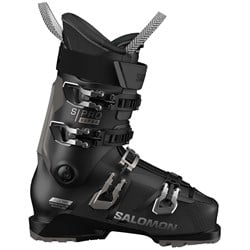
Last: 100mm
Flex: 100
Binding Compatibility: GripWalk
Ability Level: Intermediate-Advanced
The Salomon S/Pro Supra 100 GW Ski Boots are perfect for intermediate to advanced skiers. These boots offer a balance of comfort and performance. With a 100 mm last, they suit medium-width feet but can be heat molded for wider ones. The Custom Shell HD process makes it easy to mold the shell to your foot for a personalized fit. This ensures maximum comfort and better control on the slopes. The 3D instep shell reduces pressure on the forefoot and locks the heel in place, making sure your foot stays secure during fast runs. With a medium flex of 100, these boots are ideal for skiers looking for control without being overly stiff.
The boots feature four micro-adjustable aluminum buckles and a 35mm Velcro power strap for a snug fit. The My CustomFit 3D Performance Liner enhances comfort and support, ensuring you stay comfortable all day. The GripWalk soles offer excellent traction when walking on icy or slippery surfaces. With a thinner shell wall, the boots provide better energy transfer, allowing more precise control and stronger power. They are also lightweight, which helps reduce fatigue, especially after long sessions on the mountain. These boots hit the sweet spot for skiers seeking both comfort and performance without compromising on either.
What I like: Lots of thoughtful upgrades from the old X Pro.
What I don’t: Powerful or expert skiers will be left wanting more.
See the Salomon S/Pro Supra 100 See the Women’s S/Pro Supra 90
6. Lange Shadow 130 LV GW
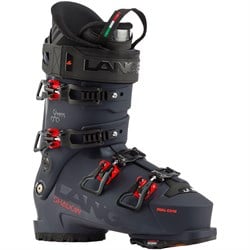
Last: 97mm
Flex: 120
Binding Compatibility: GripWalk
Ability Level: Advanced-Expert
The Lange Shadow 130 LV GW ski boots are truly changing the game for high-performance freeride boots. Traditional ski boots have relied on a two-piece overlap design for decades, but the Shadow introduces a bold new approach. It eliminates the rear rivets, replacing them with a second Suspension Blade attachment above the heel. This innovative design promises better power transfer and smoother control. The legendary Lange flex is still there, but with a more progressive feel, reducing some of the harshness when you push the boots to their limit. It’s an exciting update for expert skiers who demand precision and performance.
With a 97mm last, these boots are ideal for those with narrow, low-volume feet. The 130 flex rating is extremely stiff, making them best suited for advanced to expert skiers. The liner, featuring Auxetic Technology and a Reactive Boost Tongue, provides a snug yet comfortable fit. Lange’s Dual Core Technology enhances both comfort and stiffness, with harder plastic reinforcing the heel and softer plastic around the foot and leg. The 45mm Velcro strap and GripWalk soles add to the overall secure fit and stability. All these features come together to offer skiers improved energy transfer, control, and a more efficient ride. The Lange Shadow 130 LV GW ski boots are perfect for anyone seeking power and precision on the slopes.
What I like: Innovative tech delivers fantastic precision and power transfer.
What I don’t: Unproven over the long haul; pricey.
See the Lange Shadow 130 LV GW See the Women’s Shadow 115 LV GW
7. Atomic Hawx Ultra XTD 120
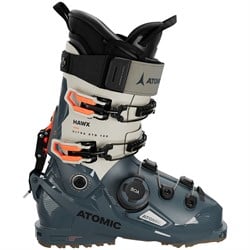
Last: 98mm
Flex: 120
Binding Compatibility: Skywalk GripWalk
Ability Level: Advanced-Expert
The Atomic Hawx Ultra XTD 120 is a freeride touring boot that balances performance with comfort. It’s similar to the popular Hawx Ultra XTD 130 but with a slightly softer flex. This 120 flex makes it perfect for skiers who spend more time touring but still want solid downhill performance. The fit is snug, especially around the ankle, which provides excellent control. The narrow 98mm last might seem tight, but Atomic’s Memory Fit technology allows for heat molding. This expands the boot up to 6mm in the forefoot and 10mm in the ankle, making it suitable for a wider range of foot shapes.
The boot features a BOA Fit System, which replaces traditional buckles for micro-adjustable precision. This evenly distributes pressure across the foot, enhancing comfort. The liner is heat moldable with 3M Thinsulate insulation, keeping feet warm even in cold conditions. The shell is made of True Flex polyurethane, ensuring consistent flex in various temperatures. The Free/Lock 4.5 mechanism provides up to 74˚ range of motion for easy ascents. Whether you’re skinning uphill or carving down, the Prolite construction and reinforced Energy Backbone deliver both lightweight performance and power. This boot is a solid choice for advanced skiers looking for a versatile option that excels in both touring and resort skiing.
What I like: Excellent performance on both groomed slopes and off-piste terrain.
What I don’t: Still can’t match the comfort, warmth, and performance of a dedicated downhill boot.
See the Atomic Hawx Ultra XTD 120 See the Women’s Hawx Ultra XTD 115
8. K2 BFC 90
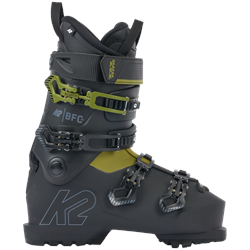
Last: 103mm
Flex: 90
Binding Compatibility: GripWalk
Ability Level: Beginner-Intermediate
The K2 BFC 90 ski boots are a dream come true for skiers with wide or high-volume feet. Right out of the box, these boots are ready to deliver comfort. They are designed for beginner to intermediate skiers who prioritize a comfortable fit. The roomy 103mm last and the softer TPU material in the instep make slipping them on and off super easy. The medium flex of 90 offers the perfect balance between support and flexibility for improving skiers. The CushFit Plus Liner, made from a mix of open cell and EVA foam, adds an extra layer of softness and support, making long days on the slopes more bearable.
Another standout feature is the fully heat-moldable shell and cuff. This means you can customize the fit even further to suit your foot shape. The four aluminum micro-adjustable buckles allow for precise fitting, and the 40mm Velcro power strap gives extra stability. Walking in ski boots isn’t always fun, but the GripWalk outsoles improve grip and comfort for walking or hiking. Overall, these boots offer excellent value for wide-footed skiers looking for both comfort and performance. I was pleasantly surprised by how well they fit without needing any adjustments, making them my new favorite boots for skiing.
What I like: Extremely comfortable and supportive and wide and high-volume fit for immediate comfort
What I don’t: Not suitable for advanced skiers
High Arch Ski Boots: Comparison Table
| BOOTS | LAST | FLEX | BINDING | ABILITY LEVEL |
|---|---|---|---|---|
| Tecnica Mach1 MV 120 | 98, 100, or 103mm | 120 | GripWalk | Advanced-Expert |
| Nordica Cruise 120 | 104mm | 120 | GripWalk | Advanced-Expert |
| Rossignol Evo 70 | 104mm | 70 | Alpine | Beginner-Intermediate |
| Nordica Speedmachine 3 100 | 100mm | 100 | GripWalk | Intermediate-Advanced |
| Salomon S/Pro Supra 100 | 100mm | 100 | GripWalk | Intermediate-Advanced |
| Lange Shadow 130 LV GW | 97mm | 120 | GripWalk | Advanced-Expert |
| Atomic Hawx Ultra XTD 120 | 98mm | 120 | Skywalk GripWalk | Advanced-Expert |
| K2 BFC 90 | 103mm | 90 | GripWalk | Beginner-Intermediate |
How to Choose Ski Boots: A Simple Guide

Skiing is a thrilling sport that requires the right equipment for comfort and performance. One of the most important pieces of gear you will need is a good pair of ski boots. They can make or break your skiing experience. Finding the right boots involves a few key steps. This guide will help you understand how to choose ski boots that fit well, keep you comfortable, and allow you to enjoy skiing to the fullest.
The Importance of a Good Fit
Fit is the most critical aspect. A proper fit ensures both comfort and control. Boots that are too tight will cause pain, while loose boots make controlling your skis difficult. A snug fit, but not too tight, is ideal. When you wear your boots, your toes should just touch the front but not be crammed. Your heel should stay in place when you move, and your ankle should feel supported.
If your boots are not well-fitted, your skiing experience can quickly turn unpleasant. Poorly fitting boots can lead to foot pain, cold feet, and even affect your balance and control on the slopes.
Understanding Ski Boot Flex Ratings
Flex rating is another important feature to look at. This refers to how stiff the boots are. A higher flex rating means stiffer boots, while a lower rating means softer, more flexible boots. Flex ratings generally range from 60 to 130.
For beginners, softer boots with a flex rating between 60 and 80 are a good option. They are easier to control and more comfortable. Intermediate skiers can look for a flex rating between 80 and 100. These offer a balance between comfort and performance. Advanced skiers often prefer boots with a flex rating of 100 or more for better control at higher speeds.
Choose the Right Boot Width (Last)
Ski boots come in different widths, referred to as the “last.” Choosing the right width is just as important as finding the right length. A narrow boot (98mm) provides a precise fit for skiers with narrow feet or those seeking maximum control. A medium-width boot (100mm) offers a balance of comfort and performance, ideal for most skiers. Wider boots (102mm or more) are more comfortable for skiers with wide feet or those who prioritize comfort over performance.
To find the right width, it’s important to know your foot shape. If you’re unsure, many ski shops offer foot assessments to help you find the right last for your boots.
Consider Your Skill Level
Your skill level is another factor in choosing the right boots. As mentioned earlier, beginners should opt for softer, more flexible boots. These are forgiving and allow for mistakes without punishing the skier too much. Advanced skiers, on the other hand, need stiffer boots. They provide more control, which is essential for skiing at higher speeds or tackling challenging terrain.
Ski boots designed for experts are usually less comfortable out of the box, but they give you better control. This is because advanced skiers typically prioritize performance over comfort. So, consider your skiing level before buying your boots.
Liner and Insulation
The liner is the soft, cushiony part inside the ski boot that touches your foot. It provides warmth and comfort. Liners come in different materials, including foam and gel. Some are heat-moldable, meaning they can be custom-fitted to your foot for added comfort. This is especially useful for people with unusual foot shapes or those who spend long days on the slopes.
Good insulation is also important, especially if you ski in cold conditions. Boots with better insulation will keep your feet warmer, allowing you to ski longer without discomfort. Make sure to choose boots that have enough insulation for the conditions you’ll be skiing in.
Buckle System
The buckle system is what keeps your foot secure in the boot. Most ski boots come with a four-buckle system, though some have three. More buckles provide a more secure fit, which is useful for advanced skiers. However, beginners may prefer fewer buckles for ease of use.
When trying on boots, pay attention to how easy or difficult it is to fasten the buckles. You want to ensure the buckles are simple to adjust, even with gloves on. It’s also important to make sure that tightening the buckles doesn’t make the boot too tight or uncomfortable.
Footbeds and Custom Insoles
Many ski boots come with a standard footbed, but these may not provide enough support for everyone. Custom insoles or aftermarket footbeds can offer better arch support, improve comfort, and even enhance performance. If you have flat feet, high arches, or any other foot issues, custom footbeds can make a big difference.
Custom insoles can be fitted at most ski shops. These can help prevent foot pain, improve circulation, and even enhance how the boots transfer power to the skis. Though they are an extra cost, they are often worth it for the added comfort and support they provide.
Trying Boots in the Store
When trying in-store, it’s best to bring the socks you usually wear for skiing. This will give you a more accurate idea of how the boots will feel on the slopes. Wear your boots for at least 15 minutes in the shop to see how they feel over time. It’s normal for ski boots to feel snug at first, but they should not cause pain or cut off circulation.
Walk around the shop to get a sense of how the boots flex and move with your feet. If the shop has a slope simulator, take advantage of it to see how the boots feel when you’re in a skiing position.
The Importance of Professional Fitting
Ski boots are a big investment, and it can be worth visiting a professional boot fitter to ensure a perfect fit. Boot fitters can make small adjustments to your boots, such as heating and molding the liners or even stretching parts of the shell. This can be especially helpful if you have any foot issues like bunions or wide feet.
Professional fitting might cost extra, but it ensures that your boots fit perfectly and are tailored to your needs. This can make all the difference when it comes to comfort and performance.
Don’t Overlook Your Socks
Ski socks play an important role in the fit and comfort of your boots. Avoid thick socks, as they can restrict circulation and cause your feet to get cold. Thin, moisture-wicking socks are best because they help keep your feet dry and warm. Proper ski socks also help prevent blisters and improve the overall feel of your boots.
When choosing ski socks, go for materials like merino wool or synthetic blends that provide warmth without being bulky.
Final Thoughts
Choosing the right ski boots can seem overwhelming, but following these steps will make the process easier. Prioritize fit, consider your skill level, and make sure your boots are appropriate for the conditions you’ll be skiing in. Remember, a good pair will last for years and significantly improve your skiing experience. So, take your time, try on different pairs, and don’t be afraid to ask for professional advice.


